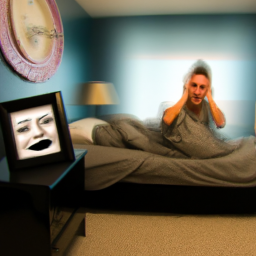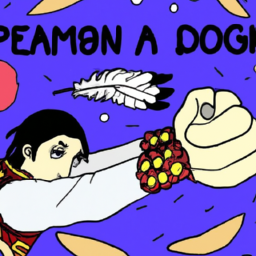Have you ever woken up from a dream thinking it was real? Feeling like what happened in your dream actually happened? I have experienced that feeling, and let me tell you, it’s truly amazing. It’s like stepping into a whole new world, where anything is possible and reality feels distant. These kinds of dreams are known as lucid dreams, and they bring a mix of excitement and fear.
Lucid dreaming is a state of consciousness where the dreamer is aware that they are dreaming. This awareness allows them to control their actions within the dream, making them feel more like an active participant rather than a passive observer. It’s like being given a backstage pass to your own subconscious mind.
But what causes these dreams to feel so vivid and real? And how can we induce them ourselves? Let’s dive deeper into the science behind lucid dreaming and uncover its mysteries together.
Key Takeaways
- Dreams that feel real when you wake up are often a result of vivid dream recall, which is linked to increased brain activity during REM sleep.
- Neurotransmitters like serotonin and acetylcholine play key roles in creating vivid dream imagery, while dopamine is associated with lucid dreaming.
- Lucid dreaming, or being aware that you are dreaming, can provide benefits like improved problem-solving skills, reduced anxiety, and enhanced creativity, but there is also a risk of sleep paralysis and exacerbating mental health problems.
- Visualization techniques, including lucid dreaming, can be used to practice real-life skills without consequences, and can improve confidence and success.
Explanation of Lucid Dreams
Have you ever experienced a lucid dream, where you’re fully aware that you’re dreaming and can even control the events of your dream? If not, it’s an incredible experience that I highly recommend.
Not only is it fascinating to witness how our minds can create such vivid imagery, but there are also many benefits to practicing lucid dreaming. One major benefit is the ability to overcome fears and anxieties. In a lucid dream, you have complete control over what happens. This means that if you’re afraid of heights, for example, you can practice facing that fear in a safe environment.
Additionally, lucid dreams have been known to enhance creativity and problem-solving skills. Techniques for inducing lucid dreams include reality checks throughout the day (asking yourself if you’re dreaming), keeping a dream journal, and setting intentions before falling asleep. With practice and patience, anyone can learn to have lucid dreams regularly.
Now let’s move on to the different types of lucid dreams.
Types of Lucid Dreams
As someone who’s experienced lucid dreams before, I can attest that there are different types of these vivid and realistic dreams. These include controllable dreams, where the dreamer is aware they’re dreaming and can manipulate the dream environment or storyline to their liking.
Semi-lucid dreams involve a partial awareness of being in a dream state, but with limited control over the dream’s content.
False awakenings are another type of lucid dream where the dreamer believes they’ve woken up from their dream, only to find themselves still dreaming when they try to interact with their surroundings.
Understanding these types of lucid dreams can help us better comprehend the complexities of our subconscious mind and how it influences our perceptions during sleep.
Controllable Dreams
Lucid dreaming allows individuals to control their dreams and experience them in a more vivid way. There are several methods for inducing lucid dreams, such as reality testing and keeping a dream journal. Once you become aware that you’re dreaming, you can take control of the dream and create your own controllable dream scenarios.
In controllable dreams, the dreamer has the power to manipulate the environment, change the storyline, or even fly without any physical limitations. It’s like having a virtual reality headset where you can create anything you desire. The possibilities are endless when it comes to controlling your dreams.
You can choose to have an adventure in space or spend time with someone who has passed away. The level of detail is incredible as all five senses come alive, making it feel real.
Transitioning into semi-lucid dreams, sometimes we might not be fully aware that we’re in a dream but still have some degree of control over our actions.
Semi-Lucid Dreams
Experiencing a semi-lucid dream can be both thrilling and unsettling, as the mind navigates between conscious control and subconscious influence. In these dreams, I’m aware that I’m dreaming but don’t have full control over my actions or surroundings. It’s like being in a virtual reality game where some parts are pre-programmed, but I can manipulate others to some extent.
Lucid dreaming techniques, such as reality checks and setting intentions before sleep, can increase the likelihood of having semi-lucid dreams. However, keeping a dream journal is equally important to improve recall and analyze patterns in dream content. Through reflection on past experiences, I can identify recurring themes or symbols that may hold personal significance.
As I delve into this exploration of the subconscious mind, it becomes easier to recognize when I’m in a semi-lucid state and use it for self-discovery or problem-solving. With this newfound awareness comes the possibility of false awakenings. It’s an even more surreal experience where one thinks they’ve woken up only to realize they’re still dreaming.
False Awakenings
If you think you’ve woken up but something just doesn’t seem right, chances are you’re experiencing a false awakening. It’s a deceiving phenomenon where you dream about waking up and going through your morning routine, only to realize later that it was all in your head.
False awakening experiences are incredibly common and can be triggered by various factors such as stress, anxiety, an irregular sleep schedule, or even consuming certain foods and drinks before bed. These dreams can leave us feeling disoriented and confused when we finally do wake up for real.
They can also be distressing if they involve nightmares or other unpleasant scenarios that we believe to be real. However, false awakenings can also serve as a signal that we need to pay more attention to our sleeping patterns and overall mental health. Understanding the triggers for false awakenings could help us better manage our sleep cycles and minimize their occurrence in the future.
As fascinating as false awakenings may be, they’re just one aspect of our complex dreaming experience. The science behind lucid dreams is still under investigation by researchers around the world who seek to uncover how our brains create these vivid alternate realities while we sleep.
The Science Behind Lucid Dreams
When delving into the science behind lucid dreams, there are three key points to consider: brain activity during sleep, the link to REM sleep, and the neurotransmitters involved.
As someone who’s experienced lucid dreaming myself, I find it fascinating to learn about what’s happening in my brain while I’m asleep.
By studying these factors, scientists hope to gain a deeper understanding of the phenomenon and potentially even develop techniques for inducing lucid dreams more reliably.
Brain Activity During Sleep
As I drift off to sleep, my brain’s activity slows down and shifts into different stages that are characterized by distinct patterns of neural firing. These stages are crucial for a good night’s rest, as they allow the brain to consolidate memories, process emotions, and recharge for the next day.
One of these stages is known as REM (Rapid Eye Movement) sleep, which is accompanied by an increase in brain activity that resembles wakefulness. During REM sleep, the brain exhibits patterns of neural firing that resemble waking consciousness but with significant differences.
One such difference is that the prefrontal cortex, which is responsible for executive functions such as decision-making and planning, becomes less active during REM sleep. This may explain why dream content can seem bizarre or illogical when compared to waking life.
Despite this lack of rationality, dreams can be interpreted as reflecting our deepest desires and fears or serving as a way for the brain to process emotional experiences. As we’ll see in the subsequent section about the ‘link to REM sleep,’ understanding these dream interpretations can shed light on how our brains work during periods of restful slumber.
Link to REM Sleep
As we discussed in the previous subtopic, brain activity during sleep is complex and varied. However, there’s a particular stage of sleep that’s been linked to vivid dream recall: REM sleep.
This stage occurs roughly every 90 minutes throughout the night and is characterized by rapid eye movement (hence the name) and increased brain activity.
During REM sleep, our brains are highly active, with many of the same regions lighting up as when we’re awake. However, there’s also a decrease in activity in certain areas responsible for logical thinking and decision-making, which may contribute to the sometimes bizarre nature of our dreams.
It’s this link between REM sleep and vivid dream recall that can make dreams feel so real when we wake up.
Moving forward into the subsequent section about neurotransmitters involved in dreaming, it’s important to note how these chemicals interact with different stages of sleep.
Neurotransmitters Involved
To understand the role of neurotransmitters in dreaming, it’s important to recognize how these chemicals interact with different stages of sleep. Two key neurotransmitters involved in vivid dreaming are serotonin and acetylcholine.
Serotonin is known to regulate mood and appetite, but it also plays a crucial role in REM sleep, the stage where most dreaming occurs. Studies have shown that low levels of serotonin can lead to less frequent and less vivid dreams.
Acetylcholine is another important neurotransmitter for dreaming. It helps maintain muscle tone during REM sleep and stimulates the brain’s visual cortex, leading to more vivid dream imagery.
On the other hand, dopamine has been found to be associated with lucid dreaming – a state where one becomes aware they are dreaming and may even take control of their dreams. While research on this connection is limited, some studies have suggested that higher levels of dopamine may increase the likelihood of experiencing lucid dreams.
As we explore further into common themes in lucid dreams, it’s worth noting that our understanding of neurotransmitters’ roles in dream experiences is still evolving. However, by examining how different chemicals interact with various stages of sleep, we can gain insight into why certain types of dreams occur and how they might be influenced by brain chemistry.
Common Themes in Lucid Dreams
You’ve likely experienced common themes in your lucid dreams, such as flying as if you have wings and soaring through the sky like a bird. These common dream symbols are known to represent feelings of liberation, freedom, and power.
Another popular theme is being chased or hunted down by someone or something. This can represent fear, anxiety, or stress in your waking life that you may not be fully aware of. It’s important to pay attention to these common themes as they can offer insights into what our subconscious mind is trying to communicate with us.
Interpreting lucid dreams can be a helpful tool for personal growth and self-discovery. By keeping a dream journal and recording details about the emotions, people, and places in your dreams, you may begin to notice patterns that reveal underlying feelings or conflicts in your waking life.
This self-awareness can lead to positive changes in behavior or decision-making. As we explore techniques for inducing lucid dreams, it’s important to remember that our subconscious mind is always working behind the scenes, offering clues and messages that can help us navigate our lives more effectively.
Techniques for Inducing Lucid Dreams
One effective technique for inducing lucid dreams is reality testing. This involves regularly asking yourself throughout the day whether you’re dreaming or not, and then performing a simple reality check such as trying to push your finger through your palm or looking at a clock twice to see if the time changes.
By making this a habit, you’ll begin to question reality in your dreams as well and become more aware of when you’re actually dreaming.
Visualization techniques can also be helpful in inducing lucid dreams. Before going to bed, visualize yourself becoming aware that you’re dreaming and taking control of the dream. You can also try visualizing specific dream scenarios that you’d like to experience while lucid, which may increase the likelihood of having those types of dreams.
By combining visualization with regular reality checks, it’s possible to significantly increase your chances of having lucid dreams and experiencing their many benefits.
Lucid dreaming has been shown to have numerous benefits including improving problem-solving skills, reducing anxiety and fear in waking life, and even helping with physical rehabilitation.
By incorporating techniques such as reality testing and visualization into your daily routine, you can start experiencing these benefits for yourself while exploring the incredible world of lucid dreaming.
Benefits of Lucid Dreaming
As if by chance, the advantages of lucid dreaming extend beyond just having control over your thoughts and actions while asleep. Studies have shown that lucid dreamers exhibit improved creativity and problem-solving abilities in their waking lives.
This is because lucid dreaming allows for a unique opportunity to practice real-life skills without any consequences. During a lucid dream, the brain is able to simulate scenarios that may be encountered in daily life. By practicing problem-solving or decision-making skills during these dreams, individuals can improve their ability to handle similar situations in reality.
Additionally, the heightened sense of awareness and control during a lucid dream can lead to increased creativity as the mind is able to explore new ideas and possibilities without limitations. However, it’s important to note that there are also risks associated with lucid dreaming.
These risks will be discussed further in the subsequent section about potential negative effects.
Risks of Lucid Dreaming
Beware of the potential risks that come with lucid dreaming. While lucid dreaming can offer many benefits, such as reducing anxiety and improving problem-solving skills, there are also some potential dangers to consider.
One major risk is the possibility of sleep paralysis, which occurs when your mind wakes up before your body does. This can leave you temporarily unable to move or speak, which can be a terrifying experience for some individuals.
Another potential risk of lucid dreaming is the possibility of managing fears and anxieties poorly. Because you have control over your dream world, it’s possible to create situations that trigger fear or anxiety without realizing it. This can lead to nightmares or even exacerbate existing mental health problems.
It’s important to approach lucid dreaming with caution, and if you do decide to try it out, make sure you’re prepared to manage any fears or anxieties that may arise.
Transitioning into the subsequent section about famous examples of lucid dreaming, it’s worth noting that many famous artists and thinkers throughout history have used their dreams as inspiration for their work. From Salvador Dali’s surreal paintings to Nikola Tesla’s scientific breakthroughs, these individuals were able to tap into their subconscious minds through lucid dreaming and use what they discovered there in their waking lives.
Famous Examples of Lucid Dreaming
When it comes to discussing famous examples of lucid dreaming, there are several groups of individuals that stand out.
Historical figures such as Aristotle and Mary Shelley were known to have experienced vivid dream experiences.
Artists and creatives like Salvador Dali and Stephen King have also talked openly about their use of lucid dreaming for inspiration in their work.
Athletes and performers such as Kobe Bryant and Paul McCartney have credited lucid dreaming with helping them develop skills in their respective fields.
Overall, the examples of lucid dreaming among these groups demonstrate how this phenomenon can be utilized in a variety of ways across different areas of life.
Historical Figures
Suddenly, you find yourself in the presence of historical figures you thought only existed in textbooks. In my dream, I had a conversation with Julius Caesar, who appeared as if he had just stepped off the podium after delivering his famous speech to the Roman Senate. Dream interpretation of historical figures suggests that they represent aspects of our own personality or symbolize qualities we admire. Perhaps my dream was reflecting my desire to be a strong leader like Caesar.
To further paint a picture for the audience, here are three other examples of historical figures appearing in dreams:
1) A man dreamed that he was having dinner with Abraham Lincoln and discussing politics. This could symbolize his own internal struggle with making important decisions.
2) A woman dreamed that she was walking through a garden with Marie Curie and learning about science from her. This may represent her fascination with scientific discovery.
3) A college student dreamed that she was dancing at a party with Albert Einstein. This could signify her desire for intellectual stimulation and growth.
As fascinating as these experiences can be, it’s important to remember that dreams are not always literal representations of reality.
Moving on to artists and creatives…
Artists and Creatives
Immerse yourself in the world of art and creativity as you encounter famous painters, writers, and musicians in your dreams. It’s not uncommon to come across Leonardo da Vinci as he sketches his latest invention or to watch Shakespeare perform one of his plays on stage. These dreams can be incredibly vivid and feel so real that it’s easy to forget they’re not actually happening.
When we dream about collaborating with artists, it can have a significant impact on our own creativity. In my own experiences, I’ve found that these dreams have sparked new ideas and ways of thinking about my own artistic pursuits. By working alongside someone who has already achieved greatness in their field, we’re able to learn from them and apply their techniques to our own work. These collaborations may only exist in our subconscious minds, but their impact on our waking lives can be profound.
Transitioning into the next section about athletes and performers: While working with artists can unlock new levels of creativity within us, dreaming about performing alongside athletes and other performers can bring a sense of physicality and athleticism to our dream worlds.
Athletes and Performers
Get ready to hit the stage and feel the rush of adrenaline as you dream about being a world-renowned athlete or performer. As an athlete, I understand how important mindset training is for performance enhancement.
Visualization techniques have been proven to be effective in helping athletes improve their performance by mentally rehearsing their desired outcome. Studies have shown that the brain cannot distinguish between a vividly imagined scenario and reality. Therefore, visualization can help athletes prepare mentally for competition by creating a mental blueprint of success.
Through constant visualization and practice, athletes can develop confidence in themselves and their abilities, leading to improved performance on game day. As performers, we also use similar techniques to help us connect with our audience and deliver our best performances every time.
As I transition into the subsequent section about personal experiences with lucid dreaming, it’s worth noting that many athletes and performers have reported experiencing dreams that feel real when they wake up. These dreams can often serve as helpful tools for practicing new skills or scenarios without physical strain or risk of injury.
With continued focus on mindset training and performance enhancement techniques like visualization and lucid dreaming, we can continue improving our craft and achieving greater success in our respective fields.
Personal Experiences with Lucid Dreaming
Have you ever had a dream where you realized you were dreaming and could control what happened next? That’s what it feels like to experience lucid dreaming.
This phenomenon has been studied extensively by scientists, who’ve found that it’s possible to train oneself to become more aware during dreams. Personal techniques for inducing lucid dreams include reality testing, which involves checking throughout the day whether one is awake or asleep; and keeping a dream journal, which can help one recognize patterns in their dreams.
The benefits of lucid dreaming are numerous: people have reported overcoming fears and phobias, improving problem-solving skills, and even enhancing their creativity. However, there are also challenges associated with this practice, such as experiencing sleep paralysis or difficulty distinguishing between waking life and dreams.
Many people who have experienced lucid dreaming report feeling a sense of empowerment and self-discovery. They often share their experiences with others who also dream lucidly, creating a community of individuals who are interested in exploring the boundaries of consciousness.
While not everyone may be able to achieve lucidity in their dreams, those who do often find it to be a rewarding and enlightening experience.
Frequently Asked Questions
Can lucid dreaming be harmful or have negative effects on mental health?
Exploring the ethics of lucid dreaming, I have found that there are potential dangers to mental health. While some may find it empowering, others experience anxiety and sleep disruption. It’s important to consider individual experiences and seek professional guidance.
How long does it typically take to master the techniques for inducing lucid dreams?
Mastering lucid dream induction techniques can take anywhere from a few weeks to several months, according to experts. To improve your chances of success, try keeping a dream journal and practicing reality checks throughout the day.
Are there any differences in lucid dreaming experiences between individuals based on culture, gender, or age?
Cultural influences may affect lucid dreaming experiences, but research is limited. Dream journaling can improve dream recall and increase the likelihood of achieving lucidity regardless of age, gender or culture.
Can lucid dreaming be used as a therapeutic tool, and if so, what types of therapeutic benefits can it provide?
Lucid dreaming is a powerful tool for creativity and exploring past traumas. Research suggests it can be used therapeutically to address anxiety, PTSD, and depression. As someone who desires to serve others, I’m excited by its potential as a healing modality.
Are there any ongoing studies or research being conducted on the potential applications of lucid dreaming?
Lucid dreaming research is ongoing with potential benefits being explored in therapy, creativity, and problem-solving. Studies are examining how the practice can improve skills and reduce anxiety.
Conclusion
In conclusion, lucid dreams are a fascinating phenomenon that allow us to explore our subconscious minds and experience things beyond our waking reality. Through my own experiences with lucid dreaming, I’ve come to appreciate the power of our imagination and the potential for personal growth through self-reflection.
One particular dream stands out in my memory. In it, I found myself standing on the edge of a cliff overlooking a vast ocean. The waves crashed against the rocks below as I took in the stunning view. Suddenly, I realized that I was dreaming and became fully aware of my surroundings.
With this realization came an overwhelming sense of freedom and possibility – like anything was within reach if only I had the courage to take that first step off the cliff.
This dream serves as a metaphor for the limitless potential we all possess within ourselves, if only we can learn to tap into it. Lucid dreaming offers us a unique opportunity to unlock this potential by exploring our deepest fears, desires, and aspirations in a safe and controlled environment.
So why not give it a try? Who knows where your dreams might take you?









